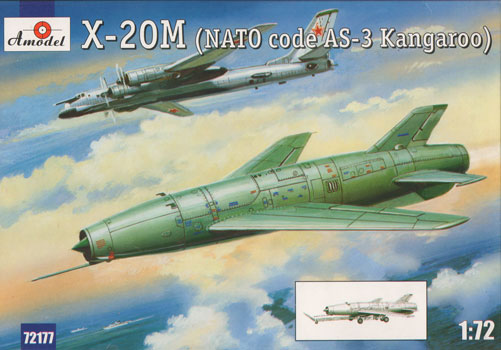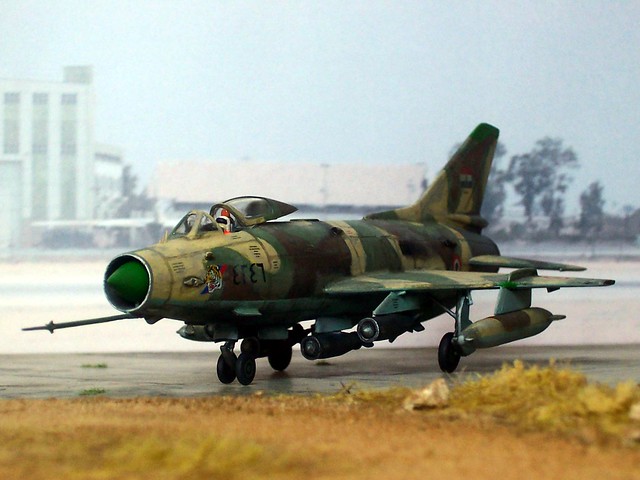Ich hau' noch einen raus! Wer spontan erkennt, was hier verbaut wurde, ist ein ziemlicher Bastelfuchs...
Basis ist nämlich die Kh-20X-Flugkörper von Amodel - ich hab' schon lange mit dem Ding geliebäugelt, um einen bemannten Jäger daraus zu machen.

verlinkt von
www.fantastic-plastic.comWer sich nicht so gut auskennt: die Kh-20 (AS-3 "Kangaroo") war ein sovietischer, luftgestarteter Nuklear-Flugkörper, entwickelt aus dem I-7U-Abfangjäger. Eine echtes "Doomsday-Gerät", und ein Riesentrümmer. Selbst in 1:72 ist das Ding noch über 20cm lang, da wird einem mulmig...
Na ja. Als mir dann kürzlich ein Freund eine Su-15 von PM spendete (ein übler Bausatz, sehr grob, und da stimmt nix dran!), machte es Klick und ich hatte auf einmal alles zusammen, um einen eigenen Jagdbomber zu stricken (s.u.)...


verlinkt von
www.aerodrome24.deUm die Chose etwas subtiler zu gestalten, habe ich das Stück keinem sovietischen Hersteller in die Schuhe geschoben, sondern Ägyptern in den späten 60ern - die glücklose Helwan HA-300 mag dem einen oder anderen bekannt sein?
Das hier ist jedenfalls draus geworden (mit und ohne Außenlasten):

1:72 Helwan Aircraft HA-410 "4642" Egyptian Air Force (EAF); 204nd Fighter-Bomber Brigade, Belbaits Airfield, around 1971 (Whif/Kit bashing) by
dizzyfugu, on Flickr

1:72 Helwan Aircraft HA-410 "4642" Egyptian Air Force (EAF); 204nd Fighter-Bomber Brigade, Belbaits Airfield, around 1971 (Whif/Kit bashing) by
dizzyfugu, on Flickr

1:72 Helwan Aircraft HA-410 "4642" Egyptian Air Force (EAF); 204nd Fighter-Bomber Brigade, Belbaits Airfield, around 1971 (Whif/Kit bashing) by
dizzyfugu, on Flickr

1:72 Helwan Aircraft HA-410 "4642" Egyptian Air Force (EAF); 204nd Fighter-Bomber Brigade, Belbaits Airfield, around 1971 (Whif/Kit bashing) by
dizzyfugu, on Flickr

1:72 Helwan Aircraft HA-410 "4642" Egyptian Air Force (EAF); 204nd Fighter-Bomber Brigade, Belbaits Airfield, around 1971 (Whif/Kit bashing) by
dizzyfugu, on Flickr

1:72 Helwan Aircraft HA-410 "4642" Egyptian Air Force (EAF); 204nd Fighter-Bomber Brigade, Belbaits Airfield, around 1971 (Whif/Kit bashing) by
dizzyfugu, on Flickr

1:72 Helwan Aircraft HA-410 "4642" Egyptian Air Force (EAF); 204nd Fighter-Bomber Brigade, Belbaits Airfield, around 1971 (Whif/Kit bashing) by
dizzyfugu, on Flickr

1:72 Helwan Aircraft HA-410 "4642" Egyptian Air Force (EAF); 204nd Fighter-Bomber Brigade, Belbaits Airfield, around 1971 (Whif/Kit bashing) - Cockpit detail by
dizzyfugu, on Flickr

1:72 Helwan Aircraft HA-410 "4642" Egyptian Air Force (EAF); 204nd Fighter-Bomber Brigade, Belbaits Airfield, around 1971 (Whif/Kit bashing) by
dizzyfugu, on Flickr

1:72 Helwan Aircraft HA-410 "4642" Egyptian Air Force (EAF); 204nd Fighter-Bomber Brigade, Belbaits Airfield, around 1971 (Whif/Kit bashing) by
dizzyfugu, on Flickr
Das Ding ist auch als Flugzeug ein ziemliches Trümmer - man kann streiten, ob es eine fette MiG-21, eine kurze Su-7 oder aufgeblähte Chengdu F-7 ist? Es passt jedenfalls stilistisch alles erstaunlich gut zusammen, auch wenn größere Umbauarbeiten notwendig waren - vor allem das Einpassen der Tragflächen und der Rumpfwanne der Su-15 (eckiger Querschnitt!) in den kreisrunden, und rund 4mm schmaleren Rumpf der Kh-20 war eine Herausforderung, die viel Chirurgie und Spachtel erforderte... Ansonsten wurde viel improvisiert, z. B. der vordere Fahrwerkschacht, das komplette Cockpit und die Außenlasten bzw. ihre Träger.
 1:72 Helwan Aircraft HA-410 (Whif/Kitbashing) - WIP
1:72 Helwan Aircraft HA-410 (Whif/Kitbashing) - WIP by
dizzyfugu, on Flickr
 1:72 Helwan Aircraft HA-410 (Whif/Kitbashing) - WIP
1:72 Helwan Aircraft HA-410 (Whif/Kitbashing) - WIP by
dizzyfugu, on Flickr
Bemalt wurde komplett per Pinsel, in einem "landestypischen" Anstrich namens "Nil" oder auch "Nildelta", Farbwahl erfolgte Pi mal Daumen nach Bildern typischer EAF-Flieger sowie diversen Modellbau-Quellen, da bei der ägyptischen Luftwaffe alles an Farbe auf die Maschinen der frühen 70er gepackt wurde, was man finden konnte - bis zum Autolack! Es gibt daher m. E. keine verbindlichen Farbschemata oder Farbangaben.
Nichtsdestotrotz: ein sehr stimmiges Whif-Modell, m. E. erstaunlich "überzeugend" und sehr subtil.
 Und zum Schluß, die Story dazu:The Helwan Aircraft HA-410 (Arabic: حلوان ٤٠٠) was an indigenous supersonic jet fighter aircraft developed in Egypt during the late 1960s. Its design took place in the wake of the less successful lightweight HA-300 interceptor, designed by famous German aircraft engineer Willy Messerschmitt. Like its smaller stable mate, the HA-410 was an ambitious project for Egypt, at the time seeking to expand both its aerial civilian and defence industry.
Und zum Schluß, die Story dazu:The Helwan Aircraft HA-410 (Arabic: حلوان ٤٠٠) was an indigenous supersonic jet fighter aircraft developed in Egypt during the late 1960s. Its design took place in the wake of the less successful lightweight HA-300 interceptor, designed by famous German aircraft engineer Willy Messerschmitt. Like its smaller stable mate, the HA-410 was an ambitious project for Egypt, at the time seeking to expand both its aerial civilian and defence industry.
Compared to the HA-300, the HA-400, how the project was initially called, was a much bigger aircraft, comparable to the North American F-100 ‘Super Sabre’ and similar in operational and political respects to the Indian Hindustan Industries ‘Marut’ fighter. The aircraft was planned as a home-grown alternative to the Soviet Su-7 fighter bomber, which had been acquired by the Egyptian Air Force (EAF; Arabic: القوات الجوية المصرية, Al-Qūwāt al-Gawwīyä al-Miṣrīyä) and employed in the Six Day War in 1967. This event uncovered certain deficiencies of the type, like the Su-7’s relatively poor ordnance load and range, as well as its high landing speed.
Under the influence of the ensuing War of Attrition with Israel, the HA-400 prototype was designed around the same Lyulka AL-7 turbojet engine as the Su-7, inheriting its power but also the poor reliability – even though the engine’s high resilience against FOD, sand and dust was a vital aspect for the EAF.
The HA-400’s design was conventional, with a barrel-shaped (non-area-ruled) fuselage, reminiscent of the US-American North American F-100 Super Sabre or the French Dassault Super Mystère B2. But the HA-400 incorporated different features like a translating centerbody, a movable cone in the air intake for managing airflow to the engine at supersonic speeds. It also featured clipped delta mid-wings with a 60° sweep, not unlike those of the MiG-21 and a one-piece, all-moving tailplane.
The main landing gear retracted inwards, partly into the lower fuselage, the twin-wheeled front landing gear retracted forward. The landing gear was rigid and suitable for operations on semi-prepared airfields. The pilot sat in a pressurized cockpit, offering better for- and downward vision than the Su-7.
The Armament comprised two 30mm cannons in the lower forward fuselage, plus sevem ordnance hardpoints for a total external weapon load of about 3 tons.
The first prototype flew on August 6th 1968, two additional airframes followed. The EAF’s operational evaluation from November 1968 to December 1996 found the new fighter to have superior performance but declared it not ready for wide-scale deployment due to various deficiencies. These findings were subsequently confirmed during operational suitability tests. Particularly troubling was the poor directional instability in certain regimes of flight. The aircraft could develop a sudden yaw and roll which would happen too fast for the pilot to correct and would eventually overstress the aircraft structure to disintegration. As a remedy, the fin was enlarged and a ventral fin for better longitudinal stability added. Another critical point was field performance: the initially pure delta-winged HA-400 showed poor take-off and landing characteristics, offering almost no improvement in comparison with the Su-7.
Helwan Aircraft investigated a new wing design with extended wingtips for an increased wing area and boundary layer control. The result was a new "cranked" wing, with wingtips at a shallower sweep of only 45° just outboard of the wing fence. The new wing also featured a boundary-layer control (BLC, "blown flaps") system, with engine air bleed blown over the flaps to keep them effective at lower speeds. These improvements made takeoffs and landings less ‘hot’ and intimidating. Unfortunately, the Lyulka AL-7F-1 didn't provide enough bleed air to make the BLC system very effective, but the new wing alone improved slow speed flying characteristics enough to justify its use. An additional brake parachute, housed in a fairing at the fin’s base, reduced landing distance even further.
Under the lingering tense atmosphere with Israel, serial production of the modified aircraft, which had been re-designated HA-410 by November 1969, started in early 1970. Soon the new aircraft saw their baptism in fire in 1973 during the Yom Kippur War. Success was limited, though, due to teething troubles with the hydraulic and BLC system, general engine unreliability and the lack of a powerful radar which would allow true all-weather/night attack capability - the HA-410 only featured a RP-21 ‘Sapfir’ radar system, the same as used in export versions of the MiG-21. Consequently, the HA-410 was almost exclusively used in the daylight ground attack role, even though some machines were, equipped with up to four IR-guided K-13 AAMs, used for point defence around air bases. EAF HA-410 were later also actively deployed in the Egyptian-Libyan War, a border skirmish in July 1977.
A total of 75 aircraft were built, including 13 two-seated trainers, equipping three EAF squadrons, made exclusively up from this type. The EAF was the only user of the HA-410. Yugoslavia showed interest in the type in the late 70ies, as well as India, but no plane was ever exported. The HA-410, as an aircraft, proved to be tough and capable, despite its reliability shortcomings and stability problems which called for an alert pilot. No aircraft were ever lost in air-to-air combat. However, twelve were lost due to accidents and technical failures, six were lost to ground fire and three were lost due to friendly AA fire, since the HA-410’s silhouette was easily mistaken for an Israeli Super Mystère B2.
The last examples were withdrawn from service in 1988 and consequently scrapped, being replaced by Su-20/22 and F-16.General characteristics:Crew: 1
Length (fuselage only): 50 ft. 8 in (15.48m),
Length incl. pitot: 57 ft 8½ in (17.57 m)
Wingspan: 28 ft 7¼ in (8.71 m)
Wing area: 394 ft² (36.6 m²)
Wing loading: 77.4 lb/ft² (379 kg/m²)
Height: 16 ft 9 in (5.11 m)
Empty weight: 21,000 lb (9,500 kg)
Loaded weight: 28,847 lb (13,085 kg)
Powerplant:1× Lyulka AL-7F-1 turbojet with 66.6 kN (14,980 lbs) of dry thrust of and 94.1 kN (22,150 lbs) with afterburner
Performance:Maximum speed: 1.025 mph (895 knots/1.650 km/h/Mach 1.52) at 36,000 ft (11,000 m)
Cruise speed: 570 mph (495 knots/915 km/h)
Service ceiling: 59.000 ft (18.000 m)
Range: 1.580 km (981 miles)
Ferry range: 3.200 km (2.000 mi) with drop tanks
Rate of climb: 31,950 ft/min (162.3 m/s)
Armament:2× 30 mm Nudelmann-Richter NR-30 cannons (120 rounds per gun) in the lower front fuselage.
Seven hardpoints (3× under-fuselage, 4× under-wing, outer pair “wet” for drop tanks) for a total of 7,040 lbs (3,190 kg) of ordnance, including drop tanks, unguided missiles, iron bombs, napalm tanks and K-13 AAMs.
Vielen Dank für die Aufmerksamkeit.
